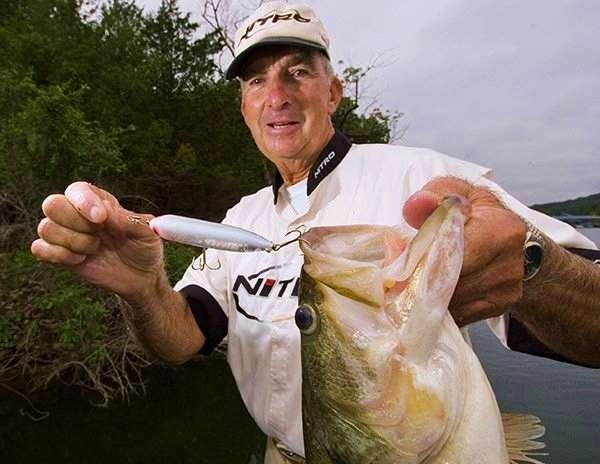
A short while ago, our sport lost one of its best. Longtime Bassmaster, Charlie Campbell passed away at age 87.
Widely known for his topwater skills, Charlie accomplished many things in his life. He was a star athlete in high school, and later coached a varsity basketball team to a Missouri state championship.
He won the B.A.S.S. Federation National Championship in 1974, and three years later began a long, productive career as a consultant/representative to Bass Pro Shops, where he helped design the first Tracker bass boats.
He was inducted into the Bass Fishing Hall of Fame in 2008.
Fishing with Charlie
Fortunately, I got to know Charlie early in my career — while he was still competing on the B.A.S.S. Tour.
In those days, things were different. Pros were paired together in the same boat and required to work out a game plan that, in theory, was mutually beneficial. Unfortunately, that format often created conflicts … and tempers flared as a result.
That was never the case with Charlie, however. He was a true gentleman, on and off the water. If you drew Charlie, you knew you were in for a positive experience. And being new to a highly competitive game, drawing guys like him was a relief.
Whenever I drew out with a pro known for a specific skillset, I always made a point of quizzing them on their specialty. In Charlie’s case, it was his abilities with topwater walking baits like the Zara Spook and Luhr-Jensen Woodwalker — two lures that featured his signature endorsement.
He was the best at it back then, and I learned a great deal from him.
The long way around
Charlie took the technique of “walking the dog” to a whole new level. He could nearly circle the lure around emergent objects — like boulders, stumps and dock pilings. According to Charlie, the trick was to make a lengthy cast just to the side and past the target, then begin a “sidestepping” retrieve.

By keeping his rod tip down, he began with short, rhythmic pulls using only his wrist. The cadence consisted of one long pull with a slightly delayed second half pull, repeating this throughout the retrieve — one long pull, one short, one long, one short.
As you twitch the lure, line is recovered with each snap of the wrist.
Although it may sound a bit complicated, turning the reel handle comes quite naturally as you twitch the rod. The key is not to think too much about it. Charlie felt you could almost do it better blindfolded. He claimed watching the lure could cause the cadence to become erratic. Instead, he suggested concentrating on the movements of the rod tip. As the gliding lure forms slack in the line, you’ll feel it, and that’s when you twitch again.
By continuing the sidestepping retrieve, the line will wrap around the backside of the object the lure is intended to circle. Once it reaches that object, you maintain the proper cadence so that the nose of the lure continues to make intermittent contact as it circles it. This minimizes the chances of snagging the object.
Added benefits
Charlie firmly believed this repeated “bumping-the-stump” contact greatly increases the odds of provoking a bass to strike.
Also, by focusing on the cadence, he believed it improved his odds of connecting with short-striking fish. He was convinced, by concentrating more on the rod rather than the lure, you have more time to determine if a striking fish has fully committed itself.
If a fish missed the lure, Charlie would simply pause for a moment, then resume the walking action. If that failed to coax another strike, he would try a second or third cast to the same location — oftentimes making those fish commit.
Now that you know his approach, give Charlie’s technique a try. It’s fun, and it can absolutely produce the bass of a lifetime.
When and if it does, think of Charlie Campbell — one of the greatest topwater anglers of all time, and a true gentleman of the sport.





